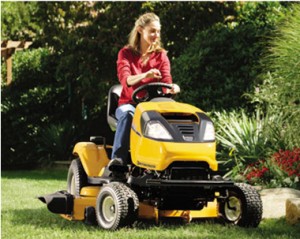It takes year-round dedication to get the best looking lawn, but no time is more important to get the lawn you want than spring. Proper application of seed, fertilizer, and herbicides along with proper watering and mowing practices can get your lawn off to a great start this year.
Prepare Your Equipment
There’s not much that you have to do to get your lawn mower running: air up the tires, add fresh fuel and oil, and making sure the cables move freely. While you’re getting your equipment out of storage, pay particular attention to the blades. If the blades are dull, they’ll bruise the top of the grass, leaving it open to infection. With diseases like fairy root and rust popping up in the spring, this is when your lawn will be most susceptible to damage.
Grass should be mulched whenever possible to return nutrients to the soil. Now is a great time to switch to a set of high lift blades to help your mower chop up grass into small, digestible pieces.
Clear the Lawn
Wind, snow, and ice can take down branches, while runoff can expose rocks in the soil. Removing this debris exposes the underlying turf so it can get sunlight, and it protects your equipment.
Get a Soil Test
If you want the best performance from your fertilizer, you need to know what the soil needs to support the grass. Getting the results can take a few weeks, so the sooner you send in the test, the better.
Apply an Herbicide
Pre-emergent herbicides can stop spring weeds from taking root, but they’ll also prevent new grass from sprouting. The more you can separate herbicide applications and overseeding, the better. Fighting crabgrass? The ideal time for application is when temperatures reach 50ºF.
Dethatch and Aerate
These processes do two entirely different things, but since they go hand-in-hand when taking care of lawns, they’re easy to confuse.
Thatch is the layer of decomposing plant matter on the surface of the soil. Some thatch is healthy as it helps fertilize the soil and reduce evaporation. Once it gets to over ½ of an inch thick, it can choke plants and cause them to grow roots over the soil. A dethatcher uses tines to rake the thatch off of the surface.
Compacted soil limits how deep roots can reach and prevents the absorption of rainwater. As the soil is kept cold and wet through the winter, weight from vehicles and foot traffic can tamp down the soil, compacting it. Aerating breaks up the soil using spikes or tines. If you’re using a core aerator, the cores can be broken up by your lawnmower. This will dull the blades, so be sure to sharpen them before you mow.
Fertilize
Using the information from your soil test, you should be able to find the right blend of nutrients for your lawn. When shopping for fertilizer, be sure to look for high levels of phosphorus, listed as “P” on the label, will encourage new growth.
Overseed
If you want a thick lawn, new grass needs to be mixed in with thinner, more mature plants. Ideally, temperatures should stay between 60 and 78 degrees when seeding, but more importantly, there must be no chance of snow or a heavy freeze.
Water
The soil should be kept moist but not saturated while new grass sprouts and older growth comes out of hibernation. Lightly water the soil two to three times a day after overseeding, then gradually shift to fewer waterings with more water applied each time.
Take it Easy on Mowing
After overseeding, wait until the new grass is two inches tall before the next mow. From there, you can mow normally, cutting up to 1/3 of the grass at one time.
Get the Parts You Need for Your Lawn Equipment
Cubparts.com is a certified dealer for Cub Cadet and their manufacturing partners. That means whether your equipment uses a Cub Cadet, Kawasaki, Honda or Briggs & Stratton engine, we have everything you need to keep it running. Looking for OEM accessories like bagging systems or broadcast spreaders? We carry those, too. We ship across the U.S. and Canada.

